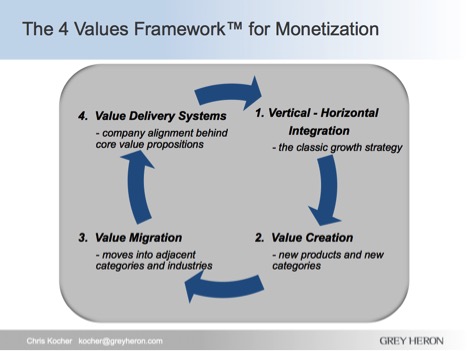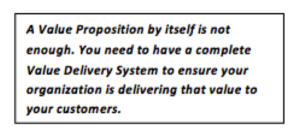 Amazon has disrupted numerous product categories and entire industries as it has rapidly grown into one of the largest companies in the world. Its monetization strategies can provide useful insights for entrepreneurs and executives seeking to rapidly grow their business.
Amazon has disrupted numerous product categories and entire industries as it has rapidly grown into one of the largest companies in the world. Its monetization strategies can provide useful insights for entrepreneurs and executives seeking to rapidly grow their business.
In this final Part IV of Amazon Style Disruption: Learning from the Masters, I’ll continue to look at Amazon’s growth strategies through the lens of the Four Values Framework. In Part 1 we saw how Amazon has excelled at Vertical and Horizontal Integration. Part II examined how Amazon has used Value Creation techniques to bring out entirely new offerings such as Amazon Prime memberships and the Alexa-powered Echo smart speaker line of products. Part III looked at Value Migration with examples from AWS and all of Amazon’s entertainment offerings.
In this Part IV article, I’ll look at the fourth of the Four Values Framework: Value Delivery Systems. I’ll illustrate it with an example of the newly announced Amazon Key remote-controlled door lock and webcam.
The Key to Providing Customer Value
Amazon excels at one of the underlying principles of Value Delivery – focusing on customer needs and problems – not technology. This enables them to build offerings that may not be obvious when growth strategies focus on technologies, internal issues or competitors. This approach also ensures you’re more likely to succeed.
Amazon is able to provide high value for many new offerings because of their focus on the long-term – the lifetime value (LTV) of the customer. As mentioned in Part II of this article in the Value Creation section on Prime, their new physical bookstores appear to be unprofitable. However, the fact that they are setting up bookstores that act as a seeding strategy to sign up Prime members is a very long-term strategy. They know Prime members will spend more money in the long run so Amazon focuses on them at the expense of near-term profit. This is a high-risk strategy and not for the faint of heart in many companies – especially those measured by their shareholders on quarterly results.
A Closer Look at Amazon’s Value Delivery Systems
A great example of the Amazon Value Delivery System is their entire e-commerce value chain. Early on, Amazon patented their One-Click ordering system. They wanted to make it as easy, fast, painless and frictionless as possible for customers to buy on the web. They extended that to physical “Dash Buttons” that literally let you push one button to reorder various products like Tide detergent and Gillette razor blades. They also enabled Dash Replenishment Systems (DRS) for automatically restocking consumable supplies.
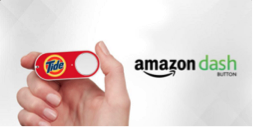 But that’s just the front end. In addition to these seamless, web and mobile app front ends, they’ve built a comprehensive back-end system to handle everything through delivery. Orders are passed to their e-commerce servers that can serve up customized web pages for each customer and make specific recommendations for add-on products to exploit cross-selling and up-selling opportunities based on order history. These are all tied into order processing systems with suppliers and other marketplaces, integrated with highly automated distribution centers, shipping and logistics systems. Then a network of third-party delivery services (FedEx, UPS, USPS) can deliver items to your door or local lockers where you can pick up packages.
But that’s just the front end. In addition to these seamless, web and mobile app front ends, they’ve built a comprehensive back-end system to handle everything through delivery. Orders are passed to their e-commerce servers that can serve up customized web pages for each customer and make specific recommendations for add-on products to exploit cross-selling and up-selling opportunities based on order history. These are all tied into order processing systems with suppliers and other marketplaces, integrated with highly automated distribution centers, shipping and logistics systems. Then a network of third-party delivery services (FedEx, UPS, USPS) can deliver items to your door or local lockers where you can pick up packages.
And, of course, providing package tracking and account status is all part of making this as visible to users as possible. Amazon wants to reassure customers of their order status and maintain high customer satisfaction.
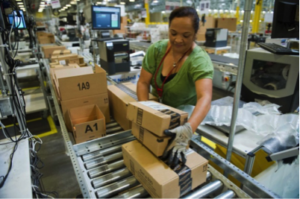 In this way, they’ve managed to control the entire Value Delivery System to your door. They make sure it is efficient, inexpensive, fast, and traceable. Furthermore, they also have dealt with post-purchase satisfaction by offering hassle free return shipping if you don’t like a product. Amazon also offers various product warranties to provide complete peace of mind over the life of the product. And of course, in a virtuous cycle, buyers can provide reviews of their purchases that help inform and reassure other buyers on Amazon as they begin their own purchase processes.
In this way, they’ve managed to control the entire Value Delivery System to your door. They make sure it is efficient, inexpensive, fast, and traceable. Furthermore, they also have dealt with post-purchase satisfaction by offering hassle free return shipping if you don’t like a product. Amazon also offers various product warranties to provide complete peace of mind over the life of the product. And of course, in a virtuous cycle, buyers can provide reviews of their purchases that help inform and reassure other buyers on Amazon as they begin their own purchase processes.
More recently they signed an agreement to allow customers to return items to Lowe’s stores as a convenience. They will likely do the same with their newly purchased Whole Food grocery stores. All of this facilitates the entire purchase and post-purchase experience to lower potential objections, reduce anxiety and deter customers from straying from Amazon.
If that wasn’t enough, Amazon has now taken their Value Delivery System initiatives to an even higher level. In November 2017, Amazon announced the Amazon Key automated door lock and camera system. Although this may appear to be just a couple of new IoT devices as part of their connected home/IoT offering, the connected door lock, web app and a webcam are much more.
 With this new product offering, Amazon is also attacking a customer objection for the “last mile” delivery in their Value Delivery System. For a segment of their potential purchasers, theft off the doorstep is a major concern and objection in the purchase process. To overcome that objection, Amazon now provides a new capability to provide greater peace of mind – in-home delivery to avoid stolen packages.
With this new product offering, Amazon is also attacking a customer objection for the “last mile” delivery in their Value Delivery System. For a segment of their potential purchasers, theft off the doorstep is a major concern and objection in the purchase process. To overcome that objection, Amazon now provides a new capability to provide greater peace of mind – in-home delivery to avoid stolen packages.
The new Amazon Key lock service enables a homeowner to provide a special code that is transmitted to a delivery person which opens the smart door lock. At the same time, the web camera records the person entering and exiting the house. In this way, the consumer receives the package delivery safely inside their house with a time-stamped, video and key code documenting the activity.
This new delivery approach avoids the anxiety over possible theft from the doorstep. Although some people may not want delivery personnel entering their home, a percentage of those with theft concerns are likely to employ this approach to solve the “owner-not-present” home delivery issue.
 Amazon Key may also enable select contractors and service people to enter the house with a time stamp and video recorded log. This could open up a whole new opportunity for small business services like plumbers, electricians, cleaning services, etc. Needless to say, if Amazon gets a cut from these local services revenues, that will provide another Value Migration opportunity. It may open up another multi-billion dollar market for Amazon – embracing the “gig-economy” service sector where Task Rabbit, Angie’s List, and others are creating marketplace platforms for local services.
Amazon Key may also enable select contractors and service people to enter the house with a time stamp and video recorded log. This could open up a whole new opportunity for small business services like plumbers, electricians, cleaning services, etc. Needless to say, if Amazon gets a cut from these local services revenues, that will provide another Value Migration opportunity. It may open up another multi-billion dollar market for Amazon – embracing the “gig-economy” service sector where Task Rabbit, Angie’s List, and others are creating marketplace platforms for local services.
All of these initiatives provide a great example of mastering an entire Value Delivery System. It has been enhanced to ensure Amazon’s core value proposition is delivered to all their customers at every step of the purchase process and during the entire life of product ownership. The attention to detail and maniacal customer focus throughout the entire Value Delivery System leads to a better customer experience, greater brand loyalty, less churn, more repeat purchases and greater future revenue streams.
Implications for Tech Marketers
The key to mastering the Value Delivery System strategy is to clearly and unambiguously define the Value Proposition you want to provide to end users. Then make sure everything in your company’s processes, technology, people hiring/training/incentives are designed around delivering that value to the customer.
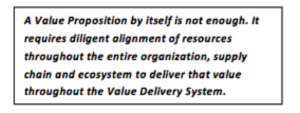 A Value Proposition by itself is not enough. It requires diligent alignment of resources throughout the entire organization, supply chain and ecosystem to deliver that value throughout the Value Delivery System. You can’t leave this to chance. You need to have a complete Value Delivery System to ensure your organization is delivering that value to your customers.
A Value Proposition by itself is not enough. It requires diligent alignment of resources throughout the entire organization, supply chain and ecosystem to deliver that value throughout the Value Delivery System. You can’t leave this to chance. You need to have a complete Value Delivery System to ensure your organization is delivering that value to your customers.
Organizational silos and even functional area fiefdoms detract from building an effective Value Delivery System. You need to be prepared to break them down- constantly. Keep the focus on delivering value to the customer/buyer – not optimizing people processes and technology around internal issues.
If you’re going to compete with Amazon and others in this disruptive environment and achieve the highest levels of customer satisfaction, you need to optimize your entire Value Delivery System. Architect the entire customer experience – don’t leave it to chance.
- Focus on the customer ahead of technology and internal issues
- Own the customer experience even if you have to rely on 3rd party services as part of your Value Delivery System
- Provide customers as much transparency as possible for greater trust and brand loyalty
- Optimize “the heck” out of your operations to reduce costs and increase profitability
- Avoid disconnects in customer experience caused by internal functional silos
- Build long-term, differentiated strategies that provide defensible moats around your business
Just building your product, offering it on a website, shipping it out, etc., is not enough. You have to understand, build and manage the entire Value Delivery System. Ensure the customer is completely satisfied and receives the full benefit of the value proposition delivered through your Value Delivery System.
Amazon’s Future Directions
As you can see, Amazon has come a long way in the last twenty years, from an online seller of physical books to an e-commerce powerhouse. Using Vertical and Horizontal Integration strategies they have moved into multiple sectors while optimizing a highly efficient Value Delivery System.
Using Value Creation strategies they have created entirely new, high-value products and services like Amazon Echo/Alexa product lines and Prime offerings. They have used Value Migration strategies to get into multi-billion-dollar adjacent markets of Cloud Computing and Entertainment.
In the future, Amazon is going to continue to do more in apparel and bespoke clothing. You should expect them to increase the number and breadth of their private label brands. They are also rumored to be considering going into real estate, mortgages, car sales, and many other areas that may be fertile territory for Amazon’s expansion and Value Migration. Amazon has also spent the last year preparing to enter the online drug distribution business. It has already received approval from multiple states for wholesale pharmacy licenses.
Transportation and logistics, one of Amazon’s core operational excellence strengths, could be another fertile new sector. They already lease a fleet of forty 767 jets and are part owner of a Chinese freight forwarding company.
Expect Amazon to continue to expand and be a major player in many of these and other sectors in the future. One of the things they are very good at is focusing new offerings on the customer – not the technology. They have a very long-term view of opportunities and are willing to take market share at the expense of profit. For more insights on Amazon’s future expansion see my presentation Disruption Amazon Style on SlideShare.
It will be interesting to see what companies are able to compete effectively with Amazon in the future. Walmart with their purchase of Jet and subsequent moves has an opportunity to regain some of the momentum and market share it has ceded to Amazon. Chinese juggernauts like Alibaba will give Amazon a run for its money, especially in Asian and other international markets. And of course, other tech giants like Google, Apple, Facebook, and Netflix will compete with Amazon across various categories.
As Amazon approaches 50% of all online e-commerce in the United States, as well as being a dominant player in many other sectors, it may come under anti-trust scrutiny. As with Microsoft years ago, Amazon’s biggest obstacle to expansion may end up being the U.S. Justice Department.
Click here to read all four parts of Disruption Amazon Style: Lessons from the Masters
Chris Kocher is a co-founder of Grey Heron, a management and strategic marketing consulting firm. He has 30 years in both strategic and hands-on operating experience helping executives and investors build revenues and shareholder value. He has consulted with over 130 companies on innovating with new business models, product strategies and monetization. Chris has held management positions at HP and Symantec in addition to advisory roles at startups. He has worked extensively on monetization, SAAS, IoT, ecosystems, partnerships and accelerating growth in new business initiatives. For help on your growth strategies, new business model or monetization initiatives, email him at kocher@greyheron.com or follow him on LinkedIn.
* The Four Values Framework (4Vs) ™ is a structured approach to developing new growth and monetization strategies developed by Grey Heron Venture Consulting. It has been used with multiple companies to identify Vertical and Horizontal integration approaches, new Value Creation areas, Value Migration into new markets and product categories as well as building complete Value Delivery Systems to ensure strategic alignment.

